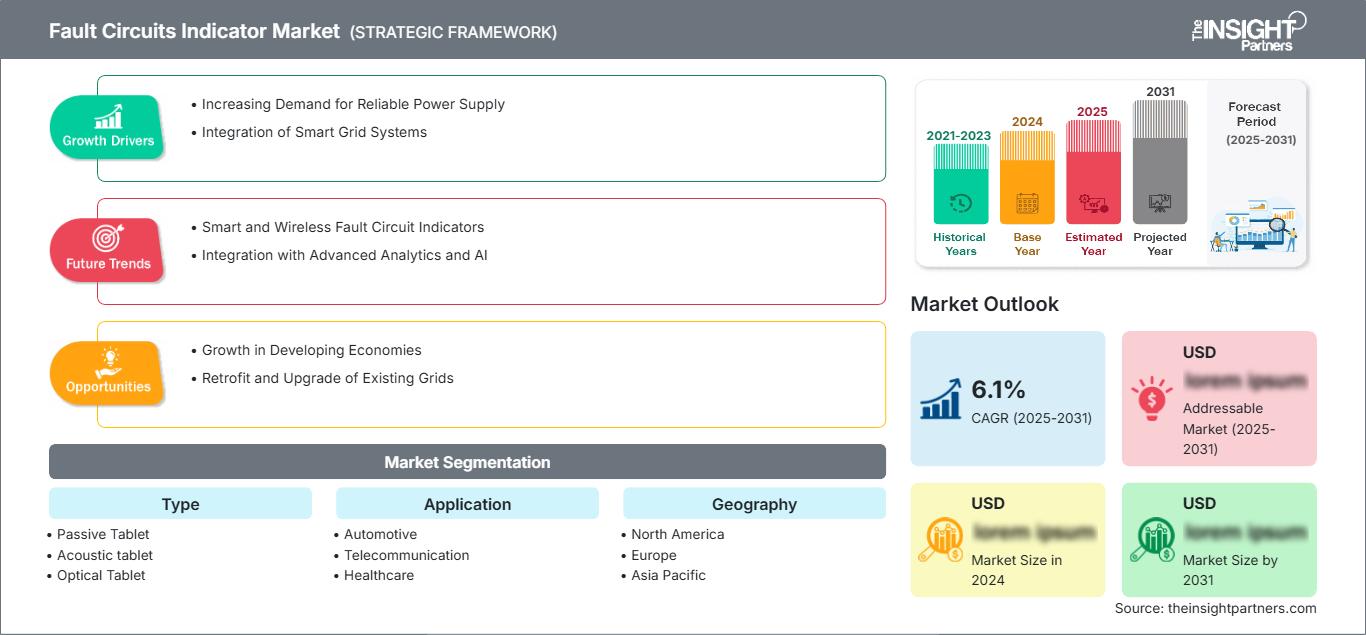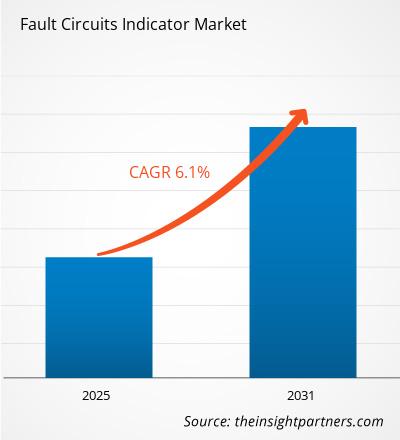Le marché des indicateurs de circuits de défaut devrait enregistrer un TCAC de 6,1 % entre 2025 et 2031, avec une taille de marché passant de XX millions de dollars américains en 2024 à XX millions de dollars américains d'ici 2031.
Le rapport est segmenté par type (tablette passive, tablette acoustique, tablette optique, autres) et application (automobile, télécommunications, santé, industrie, électronique grand public, autres). L'analyse mondiale est ensuite ventilée au niveau régional et par principaux pays. Le rapport présente la valeur en USD pour l'analyse et les segments ci-dessus.
Objectif du rapport
Le rapport sur le marché des indicateurs de circuits de défaut de The Insight Partners vise à décrire le paysage actuel et la croissance future, les principaux facteurs moteurs, les défis et les opportunités. Cela fournira des informations à diverses parties prenantes commerciales, telles que :
- Fournisseurs/fabricants de technologies : pour comprendre l’évolution de la dynamique du marché et connaître les opportunités de croissance potentielles, leur permettant de prendre des décisions stratégiques éclairées.
- Investisseurs : pour effectuer une analyse complète des tendances concernant le taux de croissance du marché, les projections financières du marché et les opportunités qui existent tout au long de la chaîne de valeur.
- Organismes de réglementation : pour réglementer les politiques et surveiller les activités du marché dans le but de minimiser les abus, de préserver la confiance des investisseurs et de maintenir l’intégrité et la stabilité du marché.
Type de segmentation du marché des indicateurs de circuits de défaut
- Tablette passive
- Tablette acoustique
- Tablette optique
Application
- Automobile
- Télécommunications
- Santé
- Industrie
- Électronique grand public
Vous bénéficierez d’une personnalisation sur n’importe quel rapport - gratuitement - y compris des parties de ce rapport, ou une analyse au niveau du pays, un pack de données Excel, ainsi que de profiter d’offres exceptionnelles et de réductions pour les start-ups et les universités
Marché des indicateurs de circuits de défaut: Perspectives stratégiques

- Obtenez les principales tendances clés du marché de ce rapport.Cet échantillon GRATUIT comprendra une analyse de données, allant des tendances du marché aux estimations et prévisions.
Facteurs de croissance du marché des indicateurs de circuits de défaut
- Demande croissante d'une alimentation électrique fiable : les services publics envisagent les indicateurs de circuits de défaut (ICF) pour localiser rapidement les défauts sur les lignes électriques et minimiser les pannes de courant en raison de la demande croissante d'une alimentation électrique continue et fiable dans les secteurs industriel, résidentiel et commercial. Les ICF permettent d'identifier et d'isoler les défauts plus rapidement avec une interruption minimale du service électrique.
- Intégration des systèmes de réseaux intelligents : le besoin de réseaux intelligents est l'un des principaux moteurs du marché des indicateurs de circuits de défaut. Les indicateurs de circuits de défaut font partie intégrante de l'infrastructure des réseaux intelligents, car ils assurent la surveillance en temps réel, la détection des défauts et la communication avec les systèmes de gestion du réseau. Les réseaux intelligents contribuent à une meilleure détection des défauts, à un fonctionnement à distance et à une meilleure résilience du réseau, autant d'amplifiés par les FCI.
Tendances futures du marché des indicateurs de circuits de défaut
- Indicateurs de circuits de défaut intelligents et sans fil : les FCI sans fil seront de plus en plus demandés. Les systèmes faciles à installer et à entretenir, sans nécessiter de câblage important, trouveront leur place. Ils peuvent communiquer avec des systèmes de contrôle centralisés pour fournir des données et des alertes en temps réel, ce qui les rend particulièrement adaptés aux emplacements éloignés et difficiles d'accès.
- Intégration avec l'analyse avancée et l'IA : les FCI intègrent l'IA et l'analyse avancée des données. Ces systèmes peuvent analyser les schémas de défaut, prédire les pannes potentielles et formuler des recommandations sur les mesures préventives. Les FCI pilotés par l'IA amélioreront la détection des pannes, automatiseront les diagnostics et réduiront l'intervention humaine, améliorant ainsi encore l'efficacité opérationnelle.
Opportunités de marché des indicateurs de circuits de défaut
- Croissance dans les économies en développement : La croissance des réseaux électriques dans les pays en développement offre une formidable opportunité au marché des indicateurs de circuits de défaut. En modernisant leurs infrastructures électriques et en améliorant la fiabilité de leur distribution d'électricité, ces pays stimuleront la demande de solutions sophistiquées de détection de pannes, telles que les FCI.
- Rénovation et mise à niveau des réseaux existants : Les services publics disposant d'infrastructures vieillissantes cherchent de plus en plus à moderniser ou à moderniser leurs systèmes existants avec des solutions de détection de pannes de haute technologie. À l'heure actuelle, les fabricants de FCI peuvent commercialiser auprès de ces entreprises des solutions de rénovation facilement intégrables à leurs réseaux.
Indicateurs de circuits de défaut : aperçu régional du marché
Les tendances régionales et les facteurs influençant le marché des indicateurs de circuits de défaut tout au long de la période de prévision ont été détaillés par les analystes de The Insight Partners. Cette section aborde également les segments et la géographie du marché des indicateurs de circuits de défaut en Amérique du Nord, en Europe, en Asie-Pacifique, au Moyen-Orient et en Afrique, ainsi qu'en Amérique du Sud et en Amérique centrale.
Portée du rapport sur le marché des indicateurs de circuits de défaut
| Attribut de rapport | Détails |
|---|---|
| Taille du marché en 2024 | US$ XX million |
| Taille du marché par 2031 | US$ XX Million |
| TCAC mondial (2025 - 2031) | 6.1% |
| Données historiques | 2021-2023 |
| Période de prévision | 2025-2031 |
| Segments couverts |
By Type
|
| Régions et pays couverts | Amérique du Nord
|
| Leaders du marché et profils d'entreprises clés |
|
Densité des acteurs du marché des indicateurs de circuits de défaut : comprendre son impact sur la dynamique des entreprises
Le marché des indicateurs de circuits de défaut connaît une croissance rapide, porté par une demande croissante des utilisateurs finaux, due à des facteurs tels que l'évolution des préférences des consommateurs, les avancées technologiques et une meilleure connaissance des avantages du produit. Face à cette demande croissante, les entreprises élargissent leur offre, innovent pour répondre aux besoins des consommateurs et capitalisent sur les nouvelles tendances, ce qui alimente la croissance du marché.

- Obtenez le Marché des indicateurs de circuits de défaut Aperçu des principaux acteurs clés
- Analyse historique (2 ans), année de base, prévision (7 ans) avec TCAC
- Analyse PEST et SWOT
- Taille du marché Valeur / Volume - Mondial, Régional, Pays
- Industrie et paysage concurrentiel
- Ensemble de données Excel
Rapports récents
Témoignages
Raison d'acheter
- Prise de décision éclairée
- Compréhension de la dynamique du marché
- Analyse concurrentielle
- Connaissances clients
- Prévisions de marché
- Atténuation des risques
- Planification stratégique
- Justification des investissements
- Identification des marchés émergents
- Amélioration des stratégies marketing
- Amélioration de l'efficacité opérationnelle
- Alignement sur les tendances réglementaires






















 Obtenez un échantillon gratuit pour - Marché des indicateurs de circuits de défaut
Obtenez un échantillon gratuit pour - Marché des indicateurs de circuits de défaut